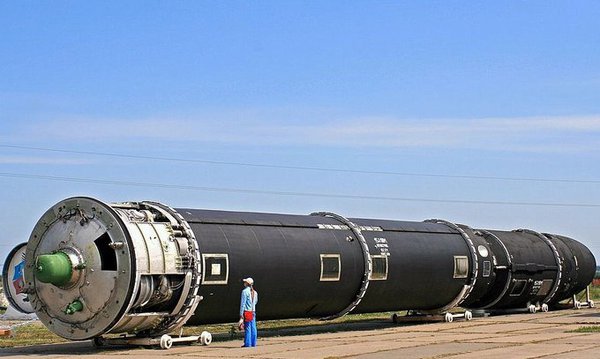
Russia’s Sarmat ICBM Faces Development Problems
Publication: Eurasia Daily Monitor Volume: 14 Issue: 27
By:

The Russian budget for 2017–2019, which the State Duma (lower chamber of parliament) adopted last December, predicts that federal budget revenues will continue to decline in the next three years and will drop to 15 percent of GDP by 2019. This would be the lowest point in 20 years. The budget deficit remains high, estimated at 3.2 percent of GDP in 2017 (Rossiyskaya Gazeta, November 16, 2016).
The crisis in the economy has had an impact on national defense spending. In 2015, it was reduced by 3.8 percent; and in 2016, it fell by another 5 percent. This year, the military will reduce its costs compared to 2016 by about 7 percent. Although, expenditures on nuclear weapons in the new budget have not changed significantly—they will amount to 51 billion rubles ($875 million) in 2017 (Ach.gov.ru, accessed February 17)—Russia’s overall economic and domestic production problems are already negatively affecting the development of new types of strategic arms. A case in point is the RS-28 “Sarmat” intercontinental ballistic missile (ICBM).
The heavy, liquid-fueled Sarmat ICBM is being developed as a replacement for Russia’s older R-36M missile (NATO Reporting name: SS-18 Satan). The Sarmat’s large payload will allow for up to 10 heavy warheads or 15 lighter ones, or as many as 24 hypersonic Yu-71 glide vehicles (Sputnik News, June 11, 2016). Production of the new missile and its prototype was entrusted to the Krasnoyarsk Machine Building Plant (Krasmash), which suffers from serious equipment depreciation issues—in 2010, fewer than 20 percent of machines at its fabrication facility were less than 20 years old (T. V. Yankova, A. M. Ragozina, “Techno-Economic Justification of Equipment Modernization at Krasmash,” Actual Problems of Aviation and Cosmonautics, No. 6: 2, 2010). The quality and lead time of the order will depend on the modernization of the production facilities at Krasmash. Efforts toward this end have already started: more than 16 billion rubles ($274 million) will reportedly be invested by 2019. And Defense Minister Sergei Shoigu has taken a personal interest in making sure these modernization goals are met (Topwar.ru, February 2, 2017).
For now, however, the Sarmat’s development has consistently fallen behind schedule. The rocket prototype should have been ready in June 2015, but, in fact, it was designed only in November. Furthermore, pop-up tests of the missile prototype were scheduled for 2015, but were postponed to the first quarter of 2016 because sub-contracting enterprises faced problems with meeting deadlines for deliveries of Sarmat components during the project’s implementation (Vpk.ru, December 15, 2015). In February 2016, the test was postponed again for 3–4 months because the launch silo was not ready. According to media reports, the issue was a lack of funding (TASS, February 20, 2016). The silo was finally complete in May, but the test launch did not take place again, this time due to technical problems with the missile prototype. The pop-up tests were, thus, postponed to November–December. However, in October, media sources reported that the pop-up tests were being rescheduled for January 2017 (Argumentiru.com, October 23, 2016). January came and went, again without a test launch. As the month drew to a close, a source in the military-industrial complex said that the tests would be attempted in March (Kommersant, January 28, 2017).
This situation strongly resembles previous chronic development and test problems of another cutting-edge Russian ballistic missile—the submarine-launched Bulava. The design of the sea missile was assigned to the Moscow Institute of Thermal Technology, even though this company had earlier been engaged in land-based nuclear missile development. And in related fashion, the Sarmat design work was assigned to the Makeyev State Rocket Center, which specializes much more in submarine-launched ballistic missiles. In light of this, it is likely that the Sarmat will follow the same development path as the Bulava—multiple failed tests and long delays in reaching operational capability. It is worth pointing out that the Bulava was declared operational only after eight years of testing. Meanwhile, the Sarmat is supposed to enter service in 2018 (Topwar.ru, December 19, 2013), which seems overly optimistic at this point.
In fact, just like with Krasmash, there are similar production problems at NPO Mashinostroyenia, charged with designing the hypersonic reentry vehicle that will be carried by the Sarmat ICBM. Both initial tests, in 2015, of the hypersonic glider ended in failure (Topwar.ru, October 28, 2016). Moreover, NPO Mashinostroyeniya is included on the sanctions list compiled by the United States government, which limits the company’s access to credit from US financial institutions. As a result, the rocket design bureau has been asking for more state aid (Izvestia, February 5, 2015).
Negative trends in the Russian economy are stretching the Sarmat ballistic missile’s development cycle and exacerbating the project’s high production costs. Greater government support for putting the ICBM’s development back on track will be difficult considering Russia’s budget deficit. As such, the Sarmat can be expected to continue to miss development deadlines. By the time the Sarmat enters service in the Russian army, it could already be outdated.



